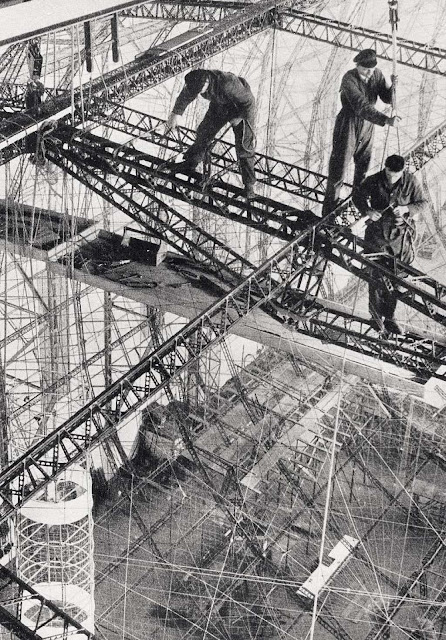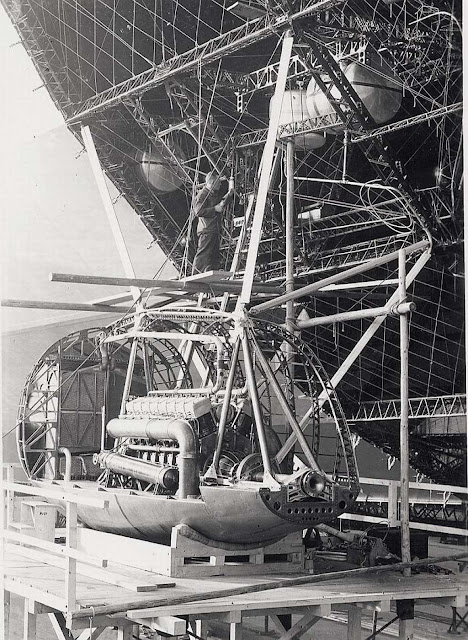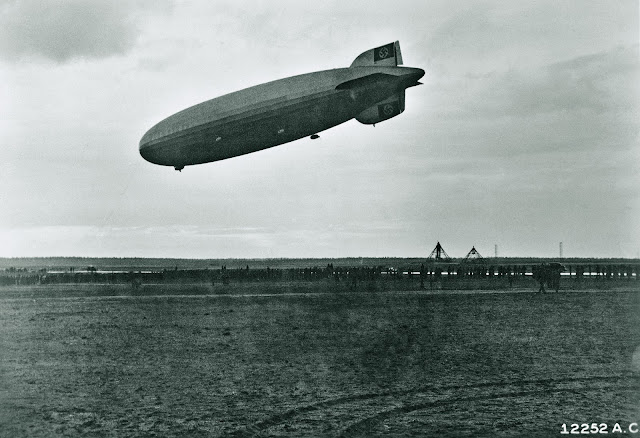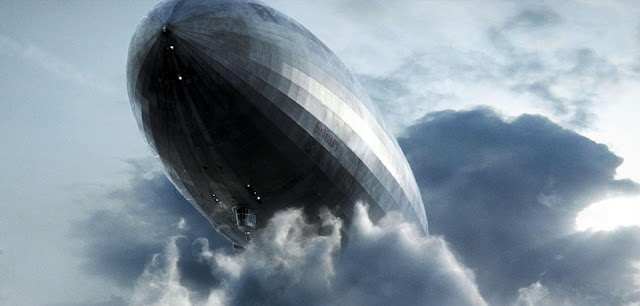The real airliner LZ 129 HINDENBURG enabled the most luxurious airtravel for decades. Imagine, gliding through the air while the landscape or the sea below can be seen ...
LZ 129 HINDENBURG marks the climax of airship construction. On May 6, 1937, the story
of civilian airship ended in a tragedy. In Lakehurst, New Jersey, the
largest flying object and has been with the similar sized LZ 130 GRAF ZEPPELIN II the most luxurious of all time. How this came about can be reconstructed logically, a series of fatal physics concatenations.
The airship LZ 129 HINDENBURG marks the climax of airship construction. It was in its time the fastest and most exclusive traveling object between Europe and America. The challenges of the construction of the giant of the heaven were immense.
by Earl of Cruise
LZ 129 HINDENBURG, 1936, in Lakehurst - digital copy of a coloured cover photo, originally by Bill Schneider, published in Dan Grossman´s book `ZEPPELIN HINDENBURG: AN ILLUSTRATED HISTORY OF LZ 129´
The dimensions of LZ 129 HINDENBURG were enormous: 245 meters length and 42.5 meters width in the largest diameter, with a gas sensing capacity of 200,000 cubic meters, it was almost twice as large as its predecessor LZ 127 GRAF ZEPPELIN. The largest passenger aircraft in the world today, the AIRBUS A380, compared to with its more than 72 meters long hull is almost small. A BOEING 737 would theoretically disappear completely in the body of HINDENBURG.
LZ 129 HINDENBURG seize comparison to BOEING 747 - Source: DEUTSCHE WELLE KULTUR, Berlin
LZ 129 HINDENBURG, upper deck with sleeping cabins, dining room, social lounge and writing room - Source: Welt Online, Birgit Holzhauser
LZ 129 HINDENBURG lower deck
with entrance, dining room, officers and crew mess and toilets and bath rooms - Source: Welt Online, Birgit Holzhauser
Ensuite facilities had not been the international standard in I. Class, neither in hotels ashore, airships or ocean liners!
Two passenger decks with a
total area of 200 square meters were integrated into the hull. They
initially offered 50 passengers on long-distance trips. The technical
and, also in the time of the global Great Depression, economic challenges
in the development of the air giants were extremely high. The
engineers of ZEPPELIN's technical office, headed by chief constructor
Friedrich Dürr, entered new territory in many aspects of airship
construction. The development of HINDENBURG is closely linked to the
development of the LZ 128 GRAF ZEPPELIN, which was stopped after the
catastrophic end of the British airship R 101. R 101, which, like
Zeppelins, used combustible hydrogen as carrier gas, had descended in
flames on October 5, 1930, in a heavy weather above a forest near
Beauvais in France. 48 people were killed. There was then a consensus
that only non-flammable helium could be considered as the carrier gas of
future Zeppelins. The German constructed airships at GOODYEAR (GOODYEAR-ZEPPELIN Co.) for the US navy U.S.S. AKRON (ZRS-4) and U.S.S. MACON (ZRS-5), as the U.S.S. LOS ANGELES (ZR-3) had been constructed to use helium.
LZ126 Los Angeles arriving at Lakehurst, New York - Source: Wikipedia
The Zeppelin LZ 128 was a planned successor model of the airship LZ 127 GRAF ZEPPELIN. The project did not go beyond the conceptual phase, despite the fact that the airship was never constructed.
The construction of LZ 128 was derived in large part from the successful predecessor LZ 127, but should be shorter and broader. It was planned to construct the vessel with a length of 233.5 meters and a diameter of 38.74 meters. The carrier gas volume was set at 155,000 cubic meters, which would correspond to 150% of the volume of the LZ 127. The ship was designed as a passenger air craft and should be able to carry 25 passengers and 10 tonnes of cargo. After the disaster of the British airship R101 in October 1930 the project was rejected. In the R101 accident, most of the victims were not lamented by the relatively hard crashing impact, but by the subsequent hydrogen fire. This event also opened the eyes of the German airship builders at LUFTSCHIFFBAU ZEPPELIN GmbH for the dangers of hydrogen filling. They rejected LZ 128 and instead constructed a much larger airship to use the incombustible gas helium as a carrier gas. Helium generates about eight percent less lift than hydrogen, and was then only available in limited quantities in the United States. This largest airship ever built (the same size was LZ 130) was given the designation LZ 129 and later was named HINDENBURG. The misfortune of HINDENBURG-caddle, in which the hydrogen carrier gas played a decisive part, was the go down in history as one of the greatest tragedies of aviation. |
The British airship R 101 that ended in similar disaster as LZ 129 HINDENBURG - Source: Wikipedia
The development of the LZ 128 still designed for hydrogen was discontinued one month after the accident. Because of the lower load-bearing capacity of the helium, the LZ 129 had to be considerably larger than the LZ 128. When
it became clear that the US, which was the only country to produce
helium in large quantities, would not be able and willing to supply the gas because
of the statutory export prohibition from 1927, it was now finally clear
that the LZ 129 had to receive hydrogen as carrier gas. In
the meantime, HINDENBURG had also been considered as a kind of hybrid
airship with helium bearing cells, into which hydrogen cells should be
added. However, the idea of reducing the helium requirement was quickly rejected for technical reasons. The
fact that hydrogen as a carrier gas offered economic benefits, a higher
load-bearing capacity and thus a payload for less money, should have `sweetened´ the decision on hydrogen, which was forced by the US export
ban. It is often said this export ban was made after January 1933, when the Nazis came legal, but illegitimate to power in Germany.
LZ 129 HINDENBURG in Lakehurst 1936 - Source: Wikipedia
The production of the
airship started slow, which may have been due to parallel construction
work, but also due to the difficult financing of the project. The
mass production of the carrier parts started at the end of 1931, in
March 1932 a first ring of the carrier partswas assembled. But it was not until the end of 1932 that the final assembly of the airship began. The work was extremely demanding. The
supports, which were mounted on the ground, had to be brought into the
vertical by special mounting rings and connected to the longitudinal beams. In the same manner, two auxiliary rings were mounted between the main rings. Thus the skeleton gradually gained its stability. The assemblers worked at a height of up to 50 meters, sometimes standing only on rope ladders or on suspended work platforms.
In the winter of 1930/31,
a first test ring was built for the planned scaffolding of the LZ
129, where load tests were carried out. Because of the enormous size of the airship a new carrier form had to be necessary. To save weight, holes were punched into the U-profiles, which were crimped at the edges to increase the stability. The edges of the profiles were also beaded. At
first it was difficult to force the profiles into the correct shape
because of the stretching limits of the duralumin without causing
cracks. However, by June 1931 the processing problems were solved together with the supplier, the Düren metal works.
LZ 129 HINDENBURG under construction - Source: Bundesarchiv, published at Wikipedia
The
construction of the control surfaces proved to be particularly
difficult, for which purpose the towers had to be erected. The bow and
stern parts were prefabricated on the ground and then assembled as
complete components. At the end of 1933 stood the basic structure. At
that time the financing of the LZ 129 HINDENBURG was finally secured.
LZ 129 HINDENBURG under construction - copy, collection Earl of Cruise, published at Klassiker der Luftfahrt, origin Sammlung: DEHLA
The
Reichsluftfahrtsministerium (RLM) gave Zeppelin an interest-free loan on
three million Reichsmarks. Actually, the Zeppelin was seen skeptical as
a means of travel in the RLM, but one had recognized the possibilities
of the LZ 129 as a propaganda instrument. In addition, the driving
operation was to be a major factor in determining the influence of the
politically disliked Zeppelin boss Hugo Eckener on the operations of the
airship. The condition for the credit was therefore the founding of DEUTSCHE ZEPPELIN REEDEREI (DZR) in Frankfurt, in which Eckener
only held the supervisory board presidency.
LZ 129 HINDENBURG, in the gondola - copy, collection Earl of Cruise, published at Klassiker der Luftfahrt, origin Sammlung: DEHLA
With the secure financing, the construction could now proceed quickly. However,
the large number of detailed problems to be solved still lasted until
September 1935, in order to make the airship ready for the application
of the outer skin. Previously, the 16 carrier gas cells had to be manufactured and inserted into the airship. They were in each case between the main rings. The gas cells consisted of so-called film material, also called film skin, a kind of sandwich material. It consisted of two layers of cotton, between which a latex layer was embedded. This design of gas-tight cells was first applied to the LZ 129.
LZ !129 HINDENBURG construction scheme - Source: globalsecurity.org
One of LZ 129 HINDENBURG´s motors, during construction - copy, collection Earl of Cruise, published at Klassiker der Luftfahrt, origin Sammlung: DEHLA
As motor units four Daimler-Benz LOF-6s
with 850 hp were selected, which drove pressure propellers in walk-in motor gondolas. The relatively slow-running 16-cylinder diesel engines were designed for continuous operation. The
V engines, which were started with pneumatic starters, were switchable
from forward to reverse, in order to be able to maneuver or decelerate
the airship better. Fourty
decades later, MTU still produced nearly identical engines under the
designation 672 as ship propulsion. The HINDENBURG received huge tanks
for a total of 88,000 liters of diesel. The fuel capacity ranged up to
16,000 kilometers. Added to this were 4,500 liters of lubricant tanks
and other containers for 40,000 liters of water ballast.
The exterior hull of LZ 129 HINDENBURG consisted of differently firm cotton and linen fabrics. The covering had to be particularly resistant because of the often rough conditions above the Atlantic. On both sides of the hull top, especially strong linen was used. The webs, each about 15 meters long, were applied by field. First, they were fixed via eyelets before they were tensioned with special devices and "sewn" with the truss framework. Special
reinforcements have been applied under the support surfaces, which
should prevent a chafing with possible fluttering of the covering
fabric. Over
the bumps further cloth strips were laid and sewn. Their final tension
was obtained by wrapping with Cellon, a tension lacquer. The first
painting was done with a pure cellon. Aluminum
powders were added to the subsequent paints, giving the airship its
silvery luster. The silvery coating protected the interior of the
envelope from intense warming and, at the same time, the fabric from the
UV radiation, which would have made it prematurely aging.
After LZ 129 HINDENBURG was put into service on 4 March 1936, HINDENBURG completed ten trips to South and North America. Before the explosion, with 35 dead and 62 surviving, the ship completed a total of 63 trips of approximately 337,000 kilometers. The journey with the most modern means of transport in the world cost in 1935 about US$ 400.00 to 450.00. This corresponds to approx € 9000.00 today. For this the traveler was pampered with great luxury. On the two-day crossing, which took place at about 140 km/h, the travelers enjoyed great luxury.
LZ 129 HINDENBURG, Dining Room - Source: Wikipedia
The picture is made from the reconstruction of the Dining room for the Zeppelin Museum in Friedrichshafen am Bodensee
LZ 129 HINDENBURG passengers in the in the Dining room - Source: airships.net
LZ 129 HINDENBURG was a through the air floating Grandhotel - in German we say `driving´ in the air - with beds for up to 72 passengers in single and double cabins. HINDENBURG's interior furnishings were designed by Fritz August Breuhaus, whose design experience included Pullman coaches for the RHEINGOLD, ocean liners, and warships of the German Navy. They slept in bunk beds, but all rooms, rather, chambers, were equipped with running hot and cold water. The upper "A" Deck contained these small passenger quarters in the middle
flanked by large public rooms: a dining room to port and a lounge and
writing room to starboard. Paintings on the dining room walls portrayed LZ 127 GRAF ZEPPELIN's
trips to South America. A stylized world map covered the wall of the
lounge. Long slanted windows ran the length of both decks. The
passengers were expected to spend most of their time in the public
areas, rather than their cramped cabins.
The lower "B" Deck contained washrooms, a mess hall for the crew, and a smoking lounge. Harold G. Dick, an American representative from the GOODYEAR ZEPPELIN COMPANY, recalled "The only entrance to the smoking room, which was pressurized to prevent the admission of any leaking hydrogen, was via the bar, which had a swiveling air lock door, and all departing passengers were scrutinized by the bar steward to make sure they were not carrying out a lit cigarette or pipe."
The lower "B" Deck contained washrooms, a mess hall for the crew, and a smoking lounge. Harold G. Dick, an American representative from the GOODYEAR ZEPPELIN COMPANY, recalled "The only entrance to the smoking room, which was pressurized to prevent the admission of any leaking hydrogen, was via the bar, which had a swiveling air lock door, and all departing passengers were scrutinized by the bar steward to make sure they were not carrying out a lit cigarette or pipe."
LZ 129 HINDENBURG, Smoking Room - Source: airship.net
LZ 129 HINDENBURG passengers in the Bar - Source: airships.net
The service differed
hardly from normal luxury hotels: If you put your shoes in front of the
door in the evening, they found freshly cleaned in the morning. Toilettes
and showers were not in the cabins, but on the other side of the aisle,
but that did not bother the passengers, which spent up to RM (Reichsmark) 4,000.00 for an easy transatlantic travel - one and a half average annual salary. Airships were nothing for `poor swallows´. There was not a jet set in the 1930s, but it was still something like a `zepp set´, even in the Third Reich. The equivalent was found with the `ship set´ on the Transatlantic liners during their golden age, pre and especially post WWI.
LZ 129 HINDENBURG Lounge, reconstruction - coutesy ZEPPELIN MUSEUM FRIEDRICHSHAFEN
However,
only half of the cabins were still occupied during most trips; most
there were more crew members on board than passengers. They were well
looked after, in modern equipped rooms, the restaurant and the lounge. the hotel and crew management was organized by HAMBURG AMERIKA LINIE, famed for its service and Food & Beverage quality since Albert Ballin´s times.
Almost 60 hours,
lasted the flight, two and a half days from Central Europe to New York -
less than half as long as the passage with the fastest passenger liners, QUEEN MARY or NORMANDIE. Or from Bremerhaven with BREMEN and EUROPA six days. It took at least
four days from the Isles of Scilly to the fire ship off New York - but
you had to get to Southampton, Cherbourg for QUEEN MARY or Le Havre for NORMANDIE to get on a liner to New York.
LZ 129 HINDENBURG drivin through the air over Manhattan - copy, collection Earl of Cruise
published at DEUTWSCHE WELLE KULTUR, Berlin, a similar still can be found at YouTube
published at DEUTWSCHE WELLE KULTUR, Berlin, a similar still can be found at YouTube
The last journey of the giant Zeppelins LZ-129 HINDENBURG ended in a tragedy. The 245 meter-long airship was launched in Frankfurt/Main on the evening of May 3rd, 1937. It should go across the Atlantic, to Lakehurst, the US airship port some 100 kilometers south of New York City. It was the 63rd tour, the pride of the German civil aviation decorated with swastikas.
At about 6 pm HINDENBURG arrived. At the landing approach, there were problems with the horizontal trim, one of the inevitable difficulties of any hovering aircraft. To stabilize the Zeppelin, Captain Max Pruss repeatedly emptied water from the ballast tanks at the stern and gas from the bow cells. About 60 meters above the landing mast, HINDENBURG finally came to a halt around 18.25 hrs. Now the rope was let down to fix the bow of LZ-129. It should now be pulled down and then fixed on the ground. Only then passengers and later the crew could disembark.
Usually.
But May 6th, 1937 nothing was normal.
The previous thunderstorm had charged the air eletrostatical.
Also the disaster in Lakehurst wrote media history. Radioreporter Herbert Morrison spoke of his landing on the spot directly on the spot. The following day the report was broadcasted by numerous radio stations. It can be heard today on countless websites, often combined with not belonging recordings of different camera songs.
On 3 May 1937, two days before the explosion, the Hindenburg started at 8:15 pm from Frankfurt and was on the way to the USA to Lakehurst. On board were sacks with airmail, which were inserted and stamped in Frankfurt. The passengers and the crew, who drove into this catastrophe, have been treated extensively in other websites, documentaries as well as feature films.
The diary note of the mechanic Theodor Ritter, who describes the approach to Cologne and the airport Butzweilerhof after his release from the hospital, is also interesting in this context:
LZ 129 HINDENBURG, childrens nursing on board - courtesy ZEPPELIN MUSEUM FRIEDRICHSHAFEN, Source: airshipnet
On May 6, 1937, at noon, LZ-129 HINDENBURG reached New York City. But because a thunderstorm arose, airship Captain Max Pruss postponed the landing at Lakehurst scheduled for 3 pm. The commander of HINDENBURG turned south over the sea to let the front go through. Two hours later the flight control in Lakehurst gave landing permission and then HINDENBURG started landing. The Zeppelin again took a course on the airship port in New Jersey.At about 6 pm HINDENBURG arrived. At the landing approach, there were problems with the horizontal trim, one of the inevitable difficulties of any hovering aircraft. To stabilize the Zeppelin, Captain Max Pruss repeatedly emptied water from the ballast tanks at the stern and gas from the bow cells. About 60 meters above the landing mast, HINDENBURG finally came to a halt around 18.25 hrs. Now the rope was let down to fix the bow of LZ-129. It should now be pulled down and then fixed on the ground. Only then passengers and later the crew could disembark.
Usually.
But May 6th, 1937 nothing was normal.
The previous thunderstorm had charged the air eletrostatical.
LZ 129 HINDENBURG approaching Lakehurst for the last time - copy, collection Earl of Cruise
Suddenly small flames lurched out of the upper tailplane at the stern. At a speed of about 15 meters per second the fire ate forward. The carrier gas in the airship had ignited. The absolute disaster for every airship.
LZ 129 HINDENBURG exploding in Lakehurst - courtesy ZEPPELIN MUSEUM FRIEDRICHSHAFEN
To minimize this risk, the Zeppelin developers constructed special cells attached to the aluminum frame, where the gas was filled into. They enabled the airship to hover. However,
one had to calculate very precisely the ballast, the load (including
passengers) and the fuel - and before the landing after a longer ride
the hydrogen to reduce the buoyancy.
LZ 129 HINDENBURG the firestorm starts and the airship is going down - photo and copyright: KL-Dokumentation
Actually this should not have happened. Germany, however, did not have access to the incombustible helium; that was only available in the USA in the 1930s - banned to be sold to Germany since 1927. So
the gas cells inside the HINDENBURG were filled with the still lighter
hydrogen, which was however highly explosive - when it mixed with
oxygen.
LZ 129 HINDENBURG the firestorm starts and the airship is going down - Source: picture alliance / Murray Becker/xag la abl
HINDENBURG disaster footage with Herbert Morrison commentary - Source: Youtube
Morrison's words "Oh
... Oh ... He's exploding, he's in flames, he's crashing, he's bursting!" May still be one of the best-known O-tones of radio history. Thus the 6th of May 1937 has also become a milestone for modern journalism.On 3 May 1937, two days before the explosion, the Hindenburg started at 8:15 pm from Frankfurt and was on the way to the USA to Lakehurst. On board were sacks with airmail, which were inserted and stamped in Frankfurt. The passengers and the crew, who drove into this catastrophe, have been treated extensively in other websites, documentaries as well as feature films.
The diary note of the mechanic Theodor Ritter, who describes the approach to Cologne and the airport Butzweilerhof after his release from the hospital, is also interesting in this context:
"Our large headlights
illuminate the area below us, the whole villages are illuminated by
daylight, we drive about 100-150 meters high, so you can see exactly. I
think we have sometimes been disturbing when such a small girl in the
dark sat on a secret bench and suddenly it was so bright !! Well it did not take long. Already
the Rhine can be seen as a matte gleam, and immediately afterwards
Cologne is in sight, the airfield is nicely red-lit, almost looks like
an Italian night. The machine telegraph arrives at "slow". I set the throttle to "stop" and keep the engine at the lowest speed. The mail of 1 May is dropped, it should be the last. But
quickly back on "march", the ship quickly takes off, passes Bergen op
Zoom Holland and bends into the canal towards the end of my guard around
10.30 am."
Theodor Ritter
|
In relation to other disasters, e.g. TITANIC (1,504 dead), STEUBEN (about 4,000 dead), GOYA (about 7,000 dead) or WILHELM GUSTLOFF (about 9,300 dead) and other disasters at sea, came from the tragedy of HINDENBURG, "only 36 died". Nevertheless this disaster is a fascination. In other words, such an intensive treatment of the decline of HINDENBURG can not be explained in many books and on many websites. How the sister sairship GRAF ZEPPELIN II and GRAF ZEPPELIN has been scrapped con now only be found on a few pages.































ReplyDeleteReally an awesome article, love reading this as it was very attractive and helpful. Please keep posting such articles.
3 Star Hotel in Mussoorie